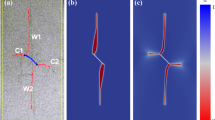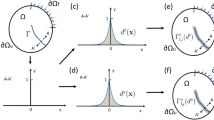Abstract
In this paper, a compressive-shear fracture model of the phase-field method is proposed to simulate the compressive-shear failure behaviours of pre-cracked rock materials and investigate their fracture mechanisms. In the proposed model, a modified Hoek–Brown criterion is incorporated into the driving term in the evolution equation of the phase field to control the crack phase field. Rock-like specimens containing single flaw and double flaws were used to validate the performance of the proposed numerical model in capturing compressive-shear fractures. The numerical results were in good agreement with the experimental observations. Subsequently the effects of flaw geometries, i.e. flaw inclination angle, spacing and continuity, on the cracking behaviours and mechanical properties of rock-like specimens containing double parallel flaws were investigated. Typical shear cracks, such as coplanar or quasi-coplanar secondary cracks and oblique secondary cracks as well as coalescence types of different shear cracks, were captured. The mechanical properties were also strongly related to the flaw geometry. These performances indicated that the proposed numerical model has ability to simulate compressive-shear cracks.



































Similar content being viewed by others
References
Ambati M, Gerasimov T, De Lorenzis L (2015a) Phase-field modeling of ductile fracture. Comput Mech 55:1017–1040
Ambati M, Gerasimov T, De Lorenzis L (2015b) A review on phase-field models of brittle fracture and a new fast hybrid formulation. Comput Mech 55:383–405
Ambati M, Kruse R, De Lorenzis L (2016) A phase-field model for ductile fracture at finite strains and its experimental verification. Comput Mech 57:149–167
Amor H, Marigo JJ, Maurini C (2009) Regularized formulation of the variational brittle fracture with unilateral contact: numerical experiments. J Mech Phys Solids 57:1209–1229
Armero F, Garikipati K (1996) An analysis of strong discontinuities in multiplicative finite strain plasticity and their relation with numerical simulation of strain localization in solids. Int J Solids Struct 33(20–22):2863–2885
Belytschko T, Lin JI (1987) A three-dimensional impact-penetration algorithm with erosion. Int J Impact Eng 5(1–4):111–127
Bobet A, Einstein HH (1998) Fracture coalescence in rock-type materials under uniaxial and biaxial compression. Int J Rock Mech Min Sci 35(7):863–888
Borden MJ, Verhoosel CV, Scott MA, Hughes TJ, Landis CM (2012) A phase-field description of dynamic brittle fracture. Comput Meth Appl Mech Eng 217:77–95
Bourdin B, Francfort GA, Marigo JJ (2000) Numerical experiments in revisited brittle fracture. J Mech Phys Solids 48:797–826
Bourdin B, Francfort GA, Marigo JJ (2008) The variational approach to fracture. J Elast 91:5–148
Chen L, Rabczuk T, Bordas SPA, Liu GR, Zeng KY, Kerfriden P (2012) Extended finite element method with edge-based strain smoothing (esm-xfem) for linear elastic crack growth. Comput Methods Appl Mech Eng 209:250–265
Eberhardt E (2012) The Hoek–Brown failure criterion. Rock Mech Rock Eng 45:981–988
Francfort GA, Marigo JJ (1998) Revisiting brittle fracture as an energy minimization problem. J Mech Phys Solids 46:1319–1342
Fries TP, Belytschko T (2010) The extended/generalized finite element method: an overview of the method and its applications. Int J Numer Meth Eng 84(3):253–304
Goswami S, Anitescu C, Chakraborty S, Rabczuk T (2020) Transfer learning enhanced physics informed neural network for phase-field modeling of fracture. Theor Appl Fract Mech 106:102447
Haeri H, Sarfarazi V, Hedayat A (2016) Suggesting a new testing device for determination of tensile strength of concrete. Struct Eng Mech 60(6):939–952
Hofacker M, Miehe C (2012) Continuum phase field modeling of dynamic fracture: variational principles and staggered FE implementation. Int J Fract 178:113–129
Hofacker M, Miehe C (2013) A phase field model of dynamic fracture: robust field updates for the analysis of complex crack patterns. Int J Numer Meth Eng 93:276–301
Huang YH, Yang SQ, Zhao J (2016) Three-dimensional numerical simulation on triaxial failure mechanical behavior of rock-like specimen containing two unparallel fissures. Rock Mech Rock Eng 49(12):4711–4729
Johnson GR, Stryk RA (1987) Eroding interface and improved tetrahedral element algorithms for high-velocity impact computations in three dimensions. Int J Impact Eng 5(1–4):411–421
Kuhn C, Müller R (2008) A phase field model for fracture. Proc Appl Math Mech 8:10223–10224
Kuhn C, Müller R (2010) A continuum phase field model for fracture. Eng Fract Mech 77:3625–3634
Lin P, Wong RHC, Tang CA (2015) Experimental study of coalescence mechanisms and failure under uniaxial compression of granite containing multiple holes. Int J Rock Mech Min Sci 77:313–327
Miehe C, Mauthe S (2016) Phase field modeling of fracture in multi-physics problems. Part III. Crack driving forces in hydro-poro-elasticity and hydraulic fracturing of fluid-saturated porous media. Comput Meth Appl Mech Eng 304:619–655
Miehe C, Hofacker M, Welschinger F (2010a) A phase field model for rate-independent crack propagation: robust algorithmic implementation based on operator splits. Comput Methods Appl Mech Eng 199:2765–2778
Miehe C, Welschinger F, Hofacker M (2010b) Thermodynamically consistent phase-field models of fracture: variational principles and multi-field FE implementations. Int J Numer Meth Eng 83:1273–1311
Miehe C, Hofacker M, Schänzel LM, Aldakheel F (2015a) Phase field modeling of fracture in multi-physics problems. Part II. Coupled brittle-to-ductile failure criteria and crack propagation in thermo-elastic-plastic solids. Comput Meth Appl Mech Eng 294:486–522
Miehe C, Mauthe S, Teichtmeister S (2015b) Minimization principles for the coupled problem of Darcy-Biot-type fluid transport in porous media linked to phase field modeling of fracture. J Mech Phys Solids 82:186–217
Miehe C, Schänzel LM, Ulmer H (2015c) Phase field modeling of fracture in multi-physics problems. Part I. Balance of crack surface and failure criteria for brittle crack propagation in thermo-elastic solids. Comput Meth Appl Mech Eng 294:449–485
Moës N, Belytschko T (2002) Extended finite element method for cohesive crack growth. Eng Fract Mech 69(7):813–833
Oliver J (1996) Modeling strong discontinuities in solid mechanics via strain softening constitutive equations part I and II. Int J Numer Meth Eng 39:3575–3623
Park CH, Bobet A (2009) Crack coalescence in specimens with open and closed flaws: a comparison. Int J Rock Mech Min Sci 46(5):819–829
Sagong M, Bobet A (2002) Coalescence of multiple flaws in a rock-model material in uniaxial compression. Int J Rock Mech Min Sci 39(2):229–241
Sarfarazi V, Haeri H (2016) A review of experimental and numerical investigations about crack propagation. Comput Concrete 18(2):235–266
Wang LF, Zhou XP (2020) Phase field model for simulating the fracture behaviors of some disc-type specimens. Eng Fract Mech 226:106870
Wang T, Ye X, Liu ZL, Chu DY, Zhuang Z (2019) Modeling the dynamic and quasi-static compression-shear failure of brittle materials by explicit phase field method. Comput Mech 64(6):1537–1556
Wei MD, Dai F, Xu NW, Zhao T (2018a) Experimental and numerical investigation of cracked chevron notched Brazilian disc specimen for fracture toughness testing of rock. Fatigue Fract Eng Mater Struct 41(1):197–211
Wei MD, Dai F, Liu Y, Xu NW, Zhao T (2018b) An experimental and theoretical comparison of CCNBD and CCNSCB specimens for determining mode I fracture toughness of rocks. Fatigue Fract Eng Mater Struct 41(5):1002–1018
Wong RHC, Chau KT (1998) Crack coalescence in a rock-like material containing two cracks. Int J Rock Mech Min Sci 35(2):147–164
Yang SQ (2011) Crack coalescence behavior of brittle sandstone samples containing two coplanar fissures in the process of deformation failure. Eng Fract Mech 78(17):3059–3081
Yang SQ, Jing HW (2011) Strength failure and crack coalescence behavior of brittle sandstone samples containing a single fissure under uniaxial compression. Int J Fract 168(2):227–250
Zhang S, Lu YQ, Wang QZ (2017) Measurement of dynamic fracture propagation toughness of rock and observation of dynamic arrest phenomenon using P-CCNBD specimens. Rock Soil Mech 38(11):3095–3105
Zhang S, Wang LF, Gao MZ (2020) Experimental and numerical study of the influence of prefabricated crack width on the fracture toughness of NSCB specimens. Rock Mech Rock Eng 53:5133–5154
Zhou XP, Zhang JZ, Wong LNY (2018) Experimental study on the growth, coalescence and wrapping behaviors of 3D cross-embedded flaws under uniaxial compression. Rock Mech Rock Eng 51(5):1379–1400
Zhou SW, Zhuang XY, Rabczuk T (2019a) Phase-field modeling of fluid-driven dynamic cracking in porous media. Comput Method Appl Mech Eng 350:169–198
Zhou SW, Zhuang XY, Rabczuk T (2019b) Phase field modeling of brittle compressive-shear fractures in rock-like materials: a new driving force and a hybrid formulation. Comput Method Appl Mech Eng 355:729–752
Zhou XP, Jia ZM, Berto F (2019c) Simulation of cracking behaviours in interlayered rocks with flaws subjected to tension using a phase-field method. Fatigue Fract Eng Mater Struct 42(8):1679–1698
Acknowledgements
The work is supported by the National Natural Science Foundation of China (Grant Nos. 51839009, 51679017) and the Graduate Scientific Research and Innovation Foundation of Chongqing, China (Grant No. CYB20030).
Author information
Authors and Affiliations
Corresponding author
Ethics declarations
Conflict of interest
The authors declare no conflict of interest.
Additional information
Publisher's Note
Springer Nature remains neutral with regard to jurisdictional claims in published maps and institutional affiliations.
Rights and permissions
About this article
Cite this article
Jia, ZM., Zhou, XP. & Berto, F. Compressive-shear fracture model of the phase-field method coupled with a modified Hoek–Brown criterion. Int J Fract 229, 161–184 (2021). https://doi.org/10.1007/s10704-021-00546-7
Received:
Accepted:
Published:
Issue Date:
DOI: https://doi.org/10.1007/s10704-021-00546-7




